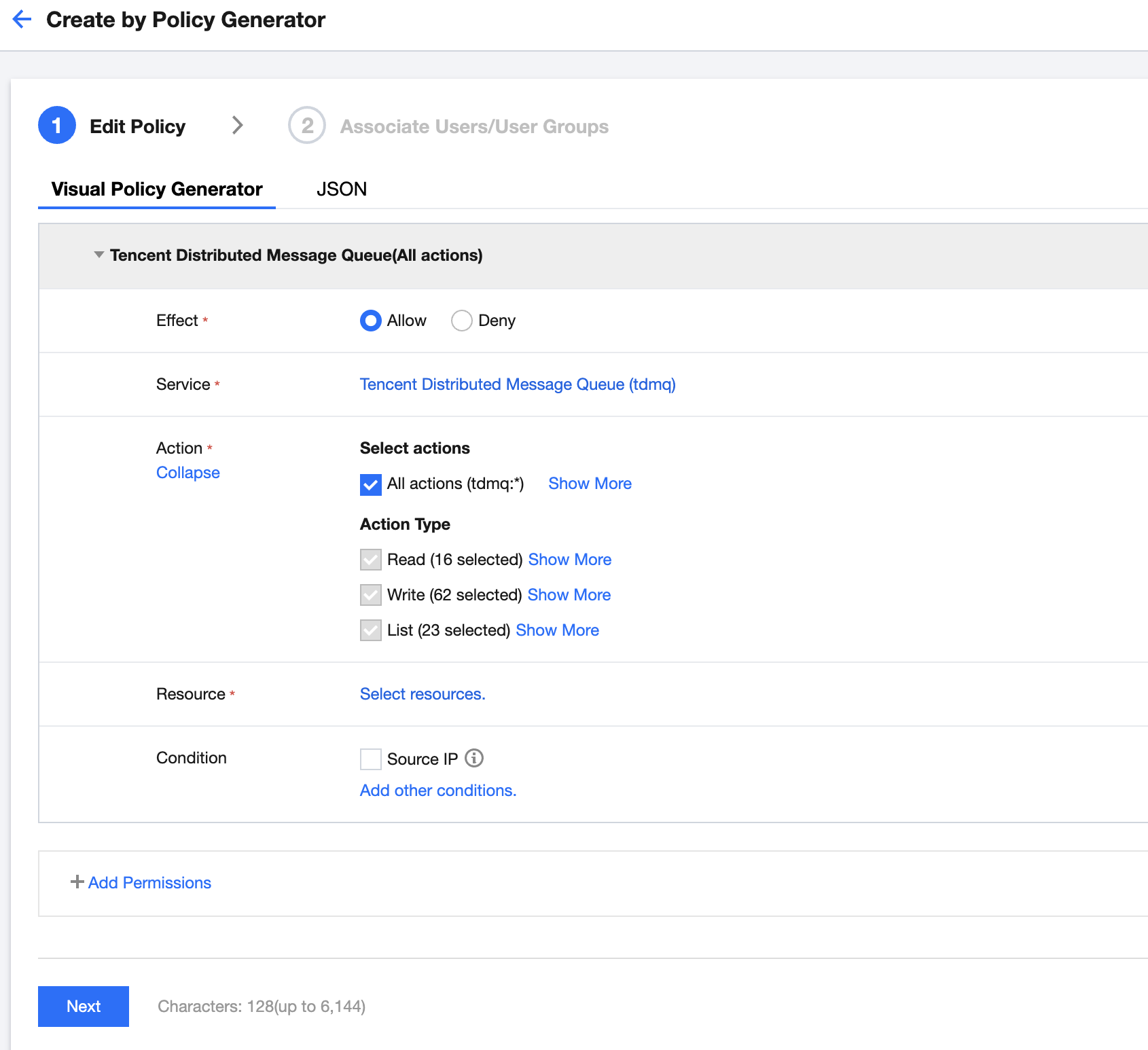- Release Notes and Announcements
- Product Introduction
- Purchase Guide
- Getting Started
- Operation Guide
- Development Guide
- Best Practices
- API Documentation
- SDK Documentation
- FAQs
- General References
- Service Level Agreement
- Contact Us
- Release Notes and Announcements
- Product Introduction
- Purchase Guide
- Getting Started
- Operation Guide
- Development Guide
- Best Practices
- API Documentation
- SDK Documentation
- FAQs
- General References
- Service Level Agreement
- Contact Us
Basic CAM Concepts
A root account authorizes sub-accounts by binding policies. The policy settings can be specific to the level of API, Resource, User/User Group, Allow/Deny, and Condition.
Account
Root account: it owns all Tencent Cloud resources and can access any of its resources.
Sub-account: it includes sub-users and collaborators.
Sub-user: it is created and fully owned by a root account.
Collaborator: it has the identity of a root account. After it is added as a collaborator of the current root account, it becomes one of the sub-accounts of the current root account and can switch back to its root account identity.
Identity credential: it includes login credentials and access certificates. Login credential refers to a user's login name and password. Access certificate refers to Tencent Cloud API keys (
SecretId and SecretKey).Resource and permission
Resource: it is an object manipulated in Tencent Cloud services. TDMQ for RabbitMQ resources include clusters, vhosts, exchanges, queues, and bindings.
Permission: it is an authorization that allows or forbids users to perform certain operations. By default, a root account has full access to all resources under it, while a sub-account does not have access to any resources under its root account.
Policy: it is a syntax rule that defines and describes one or more permissions. The root account performs authorization by associating policies with users/user groups.
Relevant Documents
Document Description | Link |
Relationship between policy and user | |
Basic policy structure | |
CAM-Enabled products |
List of APIs Supporting Resource-Level Authorization
TDMQ for RabbitMQ supports resource-level authorization. You can grant a specified sub-account the API permission of a specified resource.
APIs supporting resource-level authorization include:
API | Description | Resource Type | Six-Segment Example of Resource |
DeleteAMQPCluster | Deletes AMQP cluster | cluster | qcs::tdmq:${region}:uin/${uin}:cluster/${clusterId} |
ModifyAMQPCluster | Modifies AMQP cluster | cluster | qcs::tdmq:${region}:uin/${uin}:cluster/${clusterId} |
CreateAMQPVHost | Creates AMQP vhost | cluster | qcs::tdmq:${region}:uin/${uin}:cluster/${clusterId} |
DescribeAMQPClusters | Queries the list of AMQP clusters | cluster | qcs::tdmq:${region}:uin/${uin}:cluster/${clusterId} |
DescribeAMQPCluster | Gets the information of specific AMQP cluster | cluster | qcs::tdmq:${region}:uin/${uin}:cluster/${clusterId} |
CreateAMQPExchange | Creates AMQP exchange | vhost | qcs::tdmq:${region}:uin/${uin}:vHost/${clusterId}/${vHostId} |
ModifyAMQPVHost | Modifies AMQP vhost | vhost | qcs::tdmq:${region}:uin/${uin}:vHost/${clusterId}/${vHostId} |
DeleteAMQPVHost | Deletes AMQP vhost | vhost | qcs::tdmq:${region}:uin/${uin}:vHost/${clusterId}/${vHostId} |
CreateAMQPQueue | Creates AMQP queue | vhost | qcs::tdmq:${region}:uin/${uin}:vHost/${clusterId}/${vHostId} |
CreateAMQPRouteRelation | Creates AMQP binding | vhost | qcs::tdmq:${region}:uin/${uin}:vHost/${clusterId}/${vHostId} |
DescribeAMQPVHostConnections | Queries the list of AMQP vhost connections | vhost | qcs::tdmq:${region}:uin/${uin}:vHost/${clusterId}/${vHostId} |
DescribeAMQPVHosts | Queries the list of AMQP vhosts | vhost | qcs::tdmq:${region}:uin/${uin}:vHost/${clusterId}/${vHostId} |
DeleteAMQPExchange | Deletes AMQP exchange | exchange | qcs::tdmq:${region}:uin/${uin}:exchange/${clusterId}/${vHostId}/${exchangeName} |
ModifyAMQPExchange | Modifies AMQP exchange | exchange | qcs::tdmq:${region}:uin/${uin}:exchange/${clusterId}/${vHostId}/${exchangeName} |
DescribeAMQPExchanges | Queries the list of AMQP exchanges | exchange | qcs::tdmq:${region}:uin/${uin}:exchange/${clusterId}/${vHostId}/${exchangeName} |
DeleteAMQPQueue | Deletes AMQP queue | queue | qcs::tdmq:${region}:uin/${uin}:queue/${clusterId}/${vHostId}/${queueName} |
DescribeAMQPQueueConsumers | Gets the list of consumers in specified queue | queue | qcs::tdmq:${region}:uin/${uin}:queue/${clusterId}/${vHostId}/${queueName} |
ModifyAMQPQueue | Modifies AMQP queue | queue | qcs::tdmq:${region}:uin/${uin}:queue/${clusterId}/${vHostId}/${queueName} |
DescribeAMQPQueues | Queries the list of AMQP queues | queue | qcs::tdmq:${region}:uin/${uin}:queue/${clusterId}/${vHostId}/${queueName} |
DescribeAMQPRouteRelations | Queries the list of AMQP bindings | routeRelation | qcs::tdmq:${region}:uin/${uin}:routeRelation/${clusterId}/${vHostId}/${routeRelationId} |
DeleteAMQPRouteRelation | Deletes AMQP binding | routeRelation | qcs::tdmq:${region}:uin/${uin}:routeRelation/${clusterId}/${vHostId}/${routeRelationId} |
List of APIs Not Supporting Resource-Level Authorization
API | Description | Six-Segment Resource |
CreateAMQPCluster | Creates AMQP cluster | * |
DescribeAMQPCreateQuota | Gets user quota | * |
Authorization Scheme Examples
Full access policy
Grant a sub-user full access to the TDMQ for RabbitMQ service (for creating, managing, etc.).
1. Log in to the CAM console.
2. Click Policy on the left sidebar.
3. In the policy list, click Create Custom Policy.
4. In the Select Policy Creation Method pop-up window, select Create by Policy Generator.
5. On the Edit Policy page, click Import Policy Syntax in the top-right corner.
6. On the Import Policy Syntax page, search for TDMQ, select QcloudTDMQFullAccess in the search results, and click OK.
7. On the Edit Policy page, click Next, enter the policy name and description, and select the user/user group you want to associate.
8. Click Complete.
Read-Only access policy
The following uses granting the read-only permission of a cluster as an example.
1. Log in to the CAM console.
2. Click Policy on the left sidebar.
3. In the policy list, click Create Custom Policy.
4. In the Select Policy Creation Method pop-up window, select Create by Policy Generator and enter the policy information.


Parameter | Description |
Effect | Select Allow |
Service | Select TDMQ |
Action | Select Read operation |
Resource | Select Specific resources and click Add six-segment resource description Region: select the resource region Account: it is automatically populated Resource Prefix: clusterId Enter the ID of the cluster you want to authorize |
Condition | Allow access to specified operations only when the request is from the specified IP range |
5. Click Next, enter the policy name and description, and select the user/user group you want to associate.
6. Click Complete.

 Yes
Yes
 No
No
Was this page helpful?